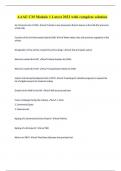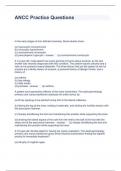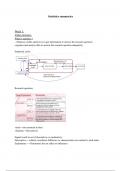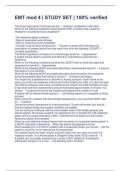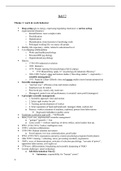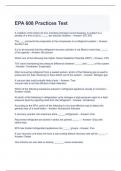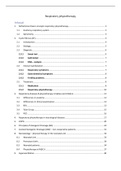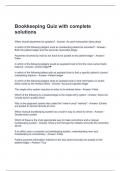Operations strategy
2e Master Business Engineering 2023-2024, KU Leuven
Prof. Maximiliano Udenio
CH1 Concepts & Frameworks...............................................................................................2
Framework......................................................................................................................... 2
Tools to Tailor operations....................................................................................................3
Competition, Competencies and Operations...................................................................... 3
Cost advantage analytics................................................................................................... 4
Analysing competitive threat.............................................................................................. 6
Efficient frontier estimation: Data Envelopment Analysis................................................. 7
Introduction.........................................................................................................................7
DEA concepts...................................................................................................................10
CCR-model, constant returns to scale............................................................................. 10
BBC-model, variable returns to scale............................................................................... 11
CCR & BBC...................................................................................................................... 11
Non-discretionary variables.............................................................................................. 11
Conclusion........................................................................................................................12
Capacity sizing and investment..........................................................................................14
Capacity portfolio strategy................................................................................................14
Capacity size and capacity costs..................................................................................... 14
Capacity size and capacity value..................................................................................... 14
Optimal capacity sizing.....................................................................................................15
Trade off: capacity-inventory-waiting time........................................................................ 16
Trading off capacity with inventory................................................................................... 17
Trading off capacity with waiting.......................................................................................18
General insights............................................................................................................... 19
Capacity timing and expansion.......................................................................................... 20
Capacity timing strategies................................................................................................ 20
Main drivers behind capacity decisions............................................................................21
Option value of waiting: decision trees.............................................................................21
Capacity timing and adjustment: reduce capacity frictions...............................................21
Product and process flexibility...........................................................................................22
Introduction.......................................................................................................................22
Process design for flexibility............................................................................................. 22
Mass customization..........................................................................................................23
Risk management and operational hedging.....................................................................23
Capacity Location and Sourcing Strategies...................................................................... 24
Drivers for globalization....................................................................................................24
Hierarchical framework for location decisions.................................................................. 24
Offshoring vs. reshoring vs. outsourcing.......................................................................... 25
Multi-sourcing................................................................................................................... 25
Improvement and innovation.............................................................................................. 25
Operations strategy drivers.............................................................................................. 25
, Continuous improvement................................................................................................. 25
Radical improvement (innovation)....................................................................................25
Demand and revenue management....................................................................................27
Introduction.......................................................................................................................27
Price controls....................................................................................................................28
Capacity controls: yield management.............................................................................. 29
CH1 Concepts & Frameworks
Framework
Operations strategy= a plan for developing resources and configuring processes such that
the resulting competencies maximize net present value of the organization. (on the long
term). To combine your resources and processes to get where you want to be,
Net present value= PV of future cashflows - investment costs of today
By planning operations smartly according to the resources and processes of your firm you
can maximize your NPV.
VCAP “equation” (VCRP)
𝑉 = 𝐶 * (𝑅 + 𝑃)
𝑉𝑎𝑙𝑢𝑒 = 𝐶𝑎𝑝𝑎𝑏𝑖𝑙𝑖𝑡𝑖𝑒𝑠 * (𝑅𝑒𝑠𝑜𝑢𝑟𝑐𝑒𝑠 + 𝑃𝑟𝑜𝑐𝑒𝑠𝑠𝑒𝑠 )
𝐶𝑎𝑝𝑎𝑏𝑖𝑙𝑖𝑡𝑖𝑒𝑠 (𝑎𝑐𝑡𝑢𝑎𝑙/ 𝑑𝑒𝑠𝑖𝑟𝑒𝑑)
𝑅𝑒𝑠𝑜𝑢𝑟𝑐𝑒𝑠 (𝑠𝑖𝑧𝑒, 𝑡𝑖𝑚𝑖𝑛𝑔 𝑎𝑛𝑑 𝑓𝑙𝑒𝑥𝑖𝑏𝑖𝑙𝑖𝑡𝑦) is in terms of capacity
𝑃𝑟𝑜𝑐𝑒𝑠𝑠𝑒𝑠 ( 𝑖𝑛𝑛𝑜𝑣𝑎𝑡𝑖𝑜𝑛, 𝑙𝑒𝑎𝑟𝑛𝑖𝑛𝑔, 𝑑𝑒𝑚𝑎𝑛𝑑 𝑚𝑎𝑛𝑎𝑔𝑒𝑚𝑒𝑛𝑡)
“ * ” because if you have zero capabilities you have no value no matter what resources or
processes you have.
Resources wil be defined in terms of capacity, arguing resources defined bij size, timing and
flexibility of assets.
Principle of alignment
Link operations strategy with a Competitive strategy.
⇒ The processes and resources have to be aligned with the competencies the firm wants to
have. If there is a good alignment between resources+ processes and the competencies,
the firm is working well.
(eg. McDo vs Michelin star restaurant)
Customer value proposition= Price, Responsiveness, Quality, Variety.
Process competencies= Cost, Flow Time, Quality, Flexibility.
Top-down (market perspective): “serve your customer”
structure follows strategy (start from customer needs)
- start from Competitive strategy ⇒ Competencies ⇒ Resources&Processes
eg.: Ikea, Zara
Bottom-up (resource perspective): “leverage your core competencies”
, strategy follows your structure (what you are good at, decides what products you will
make)
- start from Resources&Processes ⇒ Competencies ⇒ Competitive strategy
eg.: Google, Honda, Barco
! Environment not static.
Things change over time; continuously check performance, both views should be used.
⇒ There is no optimal strategy, ALIGNMENT IS KEY!
Competitive Strategy
Competencies
( cost, time, quality, Flexibility/variety)
Good competencies are needed to make sure the resources and
processes create value.
Operations strategy
Resources Processes
(Capacity Portfolio, real assets) (Activity Network)
size timing type innovation demand
Tools to Tailor operations
How can we fit the operational strategy to the competitive strategy?
- Strategic operational audit
Strategy gap analysis between reality and the strategy you aim to do.To assess
degree of alignment/ strategic fit and to develop improvement actions.
Value proposition, competencies, resources and processes
- Balanced scorecard map
Growth strategy must define desired balancing point between emphasizing
productivity or revenue growth
4 perspectives of performance: Market view, internal operations view, learning and
growth view, financial view.
Open eyes to obvious misalignments.
Financial strategies aligned with optimal NPV.
eg.: Amazon, Ikea, Google, Colruyt.
- Product-process matrix
flexibility (process) vs Variety (product)
Job shop/ flow shop vs Standardized products/ Customer solutions
Tailored operations are within the zone of alignment.
Competition, Competencies and Operations
Where do operational trade-offs come from? How can we use them to evaluate competitive
advantages?
Cost advantage analytics is going to look at all alignments
-Look at the alignments through customer and operational trade-offs
2e Master Business Engineering 2023-2024, KU Leuven
Prof. Maximiliano Udenio
CH1 Concepts & Frameworks...............................................................................................2
Framework......................................................................................................................... 2
Tools to Tailor operations....................................................................................................3
Competition, Competencies and Operations...................................................................... 3
Cost advantage analytics................................................................................................... 4
Analysing competitive threat.............................................................................................. 6
Efficient frontier estimation: Data Envelopment Analysis................................................. 7
Introduction.........................................................................................................................7
DEA concepts...................................................................................................................10
CCR-model, constant returns to scale............................................................................. 10
BBC-model, variable returns to scale............................................................................... 11
CCR & BBC...................................................................................................................... 11
Non-discretionary variables.............................................................................................. 11
Conclusion........................................................................................................................12
Capacity sizing and investment..........................................................................................14
Capacity portfolio strategy................................................................................................14
Capacity size and capacity costs..................................................................................... 14
Capacity size and capacity value..................................................................................... 14
Optimal capacity sizing.....................................................................................................15
Trade off: capacity-inventory-waiting time........................................................................ 16
Trading off capacity with inventory................................................................................... 17
Trading off capacity with waiting.......................................................................................18
General insights............................................................................................................... 19
Capacity timing and expansion.......................................................................................... 20
Capacity timing strategies................................................................................................ 20
Main drivers behind capacity decisions............................................................................21
Option value of waiting: decision trees.............................................................................21
Capacity timing and adjustment: reduce capacity frictions...............................................21
Product and process flexibility...........................................................................................22
Introduction.......................................................................................................................22
Process design for flexibility............................................................................................. 22
Mass customization..........................................................................................................23
Risk management and operational hedging.....................................................................23
Capacity Location and Sourcing Strategies...................................................................... 24
Drivers for globalization....................................................................................................24
Hierarchical framework for location decisions.................................................................. 24
Offshoring vs. reshoring vs. outsourcing.......................................................................... 25
Multi-sourcing................................................................................................................... 25
Improvement and innovation.............................................................................................. 25
Operations strategy drivers.............................................................................................. 25
, Continuous improvement................................................................................................. 25
Radical improvement (innovation)....................................................................................25
Demand and revenue management....................................................................................27
Introduction.......................................................................................................................27
Price controls....................................................................................................................28
Capacity controls: yield management.............................................................................. 29
CH1 Concepts & Frameworks
Framework
Operations strategy= a plan for developing resources and configuring processes such that
the resulting competencies maximize net present value of the organization. (on the long
term). To combine your resources and processes to get where you want to be,
Net present value= PV of future cashflows - investment costs of today
By planning operations smartly according to the resources and processes of your firm you
can maximize your NPV.
VCAP “equation” (VCRP)
𝑉 = 𝐶 * (𝑅 + 𝑃)
𝑉𝑎𝑙𝑢𝑒 = 𝐶𝑎𝑝𝑎𝑏𝑖𝑙𝑖𝑡𝑖𝑒𝑠 * (𝑅𝑒𝑠𝑜𝑢𝑟𝑐𝑒𝑠 + 𝑃𝑟𝑜𝑐𝑒𝑠𝑠𝑒𝑠 )
𝐶𝑎𝑝𝑎𝑏𝑖𝑙𝑖𝑡𝑖𝑒𝑠 (𝑎𝑐𝑡𝑢𝑎𝑙/ 𝑑𝑒𝑠𝑖𝑟𝑒𝑑)
𝑅𝑒𝑠𝑜𝑢𝑟𝑐𝑒𝑠 (𝑠𝑖𝑧𝑒, 𝑡𝑖𝑚𝑖𝑛𝑔 𝑎𝑛𝑑 𝑓𝑙𝑒𝑥𝑖𝑏𝑖𝑙𝑖𝑡𝑦) is in terms of capacity
𝑃𝑟𝑜𝑐𝑒𝑠𝑠𝑒𝑠 ( 𝑖𝑛𝑛𝑜𝑣𝑎𝑡𝑖𝑜𝑛, 𝑙𝑒𝑎𝑟𝑛𝑖𝑛𝑔, 𝑑𝑒𝑚𝑎𝑛𝑑 𝑚𝑎𝑛𝑎𝑔𝑒𝑚𝑒𝑛𝑡)
“ * ” because if you have zero capabilities you have no value no matter what resources or
processes you have.
Resources wil be defined in terms of capacity, arguing resources defined bij size, timing and
flexibility of assets.
Principle of alignment
Link operations strategy with a Competitive strategy.
⇒ The processes and resources have to be aligned with the competencies the firm wants to
have. If there is a good alignment between resources+ processes and the competencies,
the firm is working well.
(eg. McDo vs Michelin star restaurant)
Customer value proposition= Price, Responsiveness, Quality, Variety.
Process competencies= Cost, Flow Time, Quality, Flexibility.
Top-down (market perspective): “serve your customer”
structure follows strategy (start from customer needs)
- start from Competitive strategy ⇒ Competencies ⇒ Resources&Processes
eg.: Ikea, Zara
Bottom-up (resource perspective): “leverage your core competencies”
, strategy follows your structure (what you are good at, decides what products you will
make)
- start from Resources&Processes ⇒ Competencies ⇒ Competitive strategy
eg.: Google, Honda, Barco
! Environment not static.
Things change over time; continuously check performance, both views should be used.
⇒ There is no optimal strategy, ALIGNMENT IS KEY!
Competitive Strategy
Competencies
( cost, time, quality, Flexibility/variety)
Good competencies are needed to make sure the resources and
processes create value.
Operations strategy
Resources Processes
(Capacity Portfolio, real assets) (Activity Network)
size timing type innovation demand
Tools to Tailor operations
How can we fit the operational strategy to the competitive strategy?
- Strategic operational audit
Strategy gap analysis between reality and the strategy you aim to do.To assess
degree of alignment/ strategic fit and to develop improvement actions.
Value proposition, competencies, resources and processes
- Balanced scorecard map
Growth strategy must define desired balancing point between emphasizing
productivity or revenue growth
4 perspectives of performance: Market view, internal operations view, learning and
growth view, financial view.
Open eyes to obvious misalignments.
Financial strategies aligned with optimal NPV.
eg.: Amazon, Ikea, Google, Colruyt.
- Product-process matrix
flexibility (process) vs Variety (product)
Job shop/ flow shop vs Standardized products/ Customer solutions
Tailored operations are within the zone of alignment.
Competition, Competencies and Operations
Where do operational trade-offs come from? How can we use them to evaluate competitive
advantages?
Cost advantage analytics is going to look at all alignments
-Look at the alignments through customer and operational trade-offs

